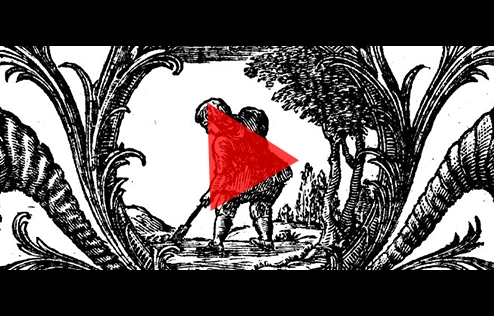1
OR avvenne, nell’anno trentesimo, nel quinto giorno del quarto mese, che essendo io sopra il fiume Chebar, fra quelli ch’erano stati menati in cattività, i cieli furono aperti, ed io vidi delle visioni di Dio.
2
Nel quinto giorno di quel mese di quell’anno, ch’era il quinto della cattività del re Gioiachin,
3
la parola del Signore fu d’una maniera singolare indirizzata ad Ezechiele, figliuolo di Buzi, sacerdote, nel paese de’ Caldei, in sul fiume Chebar; e la mano del Signore fu quivi sopra lui.
4
Io adunque vidi, ed ecco un vento tempestoso, che veniva dal Settentrione, ed una grossa nuvola, ed un fuoco avviluppato, intorno al quale vi era uno splendore; e di mezzo di quel fuoco appariva come la sembianza di fin rame scintillante.
5
Di mezzo di quello ancora appariva la sembianza di quattro animali. E tale era la lor forma: aveano sembianza d’uomini;
6
ed aveano ciascuno quattro facce, e quattro ali.
7
Ed i lor piedi eran diritti, e la pianta de’ lor piedi era come la pianta del piè d’un vitello; ed erano sfavillanti, quale è il colore del rame forbito.
8
Ed aveano delle mani d’uomo di sotto alle loro ali, ne’ quattro lor lati; e tutti e quattro aveano le lor facce, e le loro ali.
9
Le loro ali si accompagnavano l’una l’altra; essi non si volgevano camminando; ciascuno camminava diritto davanti a sè.
10
Ora, quant’è alla sembianza delle lor facce, tutti e quattro aveano una faccia d’uomo, ed una faccia di leone, a destra; parimente tutti e quattro aveano una faccia di bue, e una faccia d’aquila, a sinistra.
11
E le lor facce, e le loro ali, erano divise di sopra; ciascuno avea due ali che si accompagnavano l’una l’altra, e due altre che coprivano i lor corpi.
12
E ciascun d’essi camminava diritto davanti a sè; camminavano dovunque lo spirito si moveva; mentre camminavano, non si volgevano qua e là.
13
E quant’è alla sembianza degli animali, il loro aspetto somigliava delle brace di fuoco; ardevano in vista, come fiaccole; quel fuoco andava attorno per mezzo gli animali, dava uno splendore, e del fuoco usciva un folgore.
14
E gli animali correvano, e ritornavano, come un folgore in vista.
15
E, come io ebbi veduti gli animali, ecco una ruota in terra, presso a ciascun animale, dalle quattro lor facce.
16
L’aspetto delle ruote, e il lor lavoro, era simile al color d’un grisolito; e tutte e quattro aveano una medesima sembianza; e il loro aspetto, e il lor lavoro era come se una ruota fosse stata in mezzo di un’altra ruota.
17
Quando si movevano, si movevano tutte e quattro, ciascuna dal suo lato; elleno non si volgevano qua e là, movendosi.
18
E quant’è a’ lor cerchi, erano alti spaventevolmente; e tutti e quattro erano pieni d’occhi d’ogn’intorno.
19
E quando gli animali camminavano, le ruote si movevano allato a loro; e quando gli animali si alzavano da terra, le ruote parimente si alzavano.
20
Dovunque lo spirito si moveva, si movevano anch’essi; e le ruote si alzavano allato a quelli; perciocchè lo spirito degli animali era nelle ruote.
21
Quando quelli camminavano, le ruote altresì si movevano; quando quelli si fermavano, le ruote altresì si fermavano; e quando si alzavano da terra, le ruote altresì si alzavano da terra, allato ad essi; perciocchè lo spirito degli animali era nelle ruote.
22
E la sembianza di ciò ch’era di sopra alle teste degli animali era d’una distesa del cielo, simile a cristallo in vista, molto spaventevole; ed era distesa di sopra alle lor teste.
23
E sotto alla distesa erano le loro ali diritte, l’una di rincontro all’altra; ciascuno ne avea due altre che gli coprivano il corpo.
24
Ed io udii il suono delle loro ali, mentre camminavano; ed era simile al suono di grandi acque, alla voce dell’Onnipotente; la voce della lor favella era come il romore di un campo; quando si fermavano, bassavano le loro ali;
25
e quando si fermavano, e bassavano le loro ali, vi era una voce, che veniva d’in su la distesa, ch’era sopra le lor teste.
26
E di sopra alla distesa, ch’era sopra le lor teste, vi era la sembianza di un trono, simile in vista ad una pietra di zaffiro, e in su la sembianza del trono vi era una sembianza come della figura di un uomo che sedeva sopra esso.
27
Poi vidi come un color di rame scintillante, simile in vista a fuoco, indentro di quella sembianza di trono, d’ogn’intorno, dalla sembianza de’ lombi di quell’uomo in su; parimente, dalla sembianza dei suoi lombi in giù, vidi come un’apparenza di fuoco, intorno al quale vi era uno splendore.
28
L’aspetto di quello splendore d’ogn’intorno era simile all’aspetto dell’arco, che è nella nuvola in giorno di pioggia. Questo fu l’aspetto della somiglianza della gloria del Signore; la quale come io ebbi veduta, caddi sopra la mia faccia, e udii la voce d’uno che parlava.







